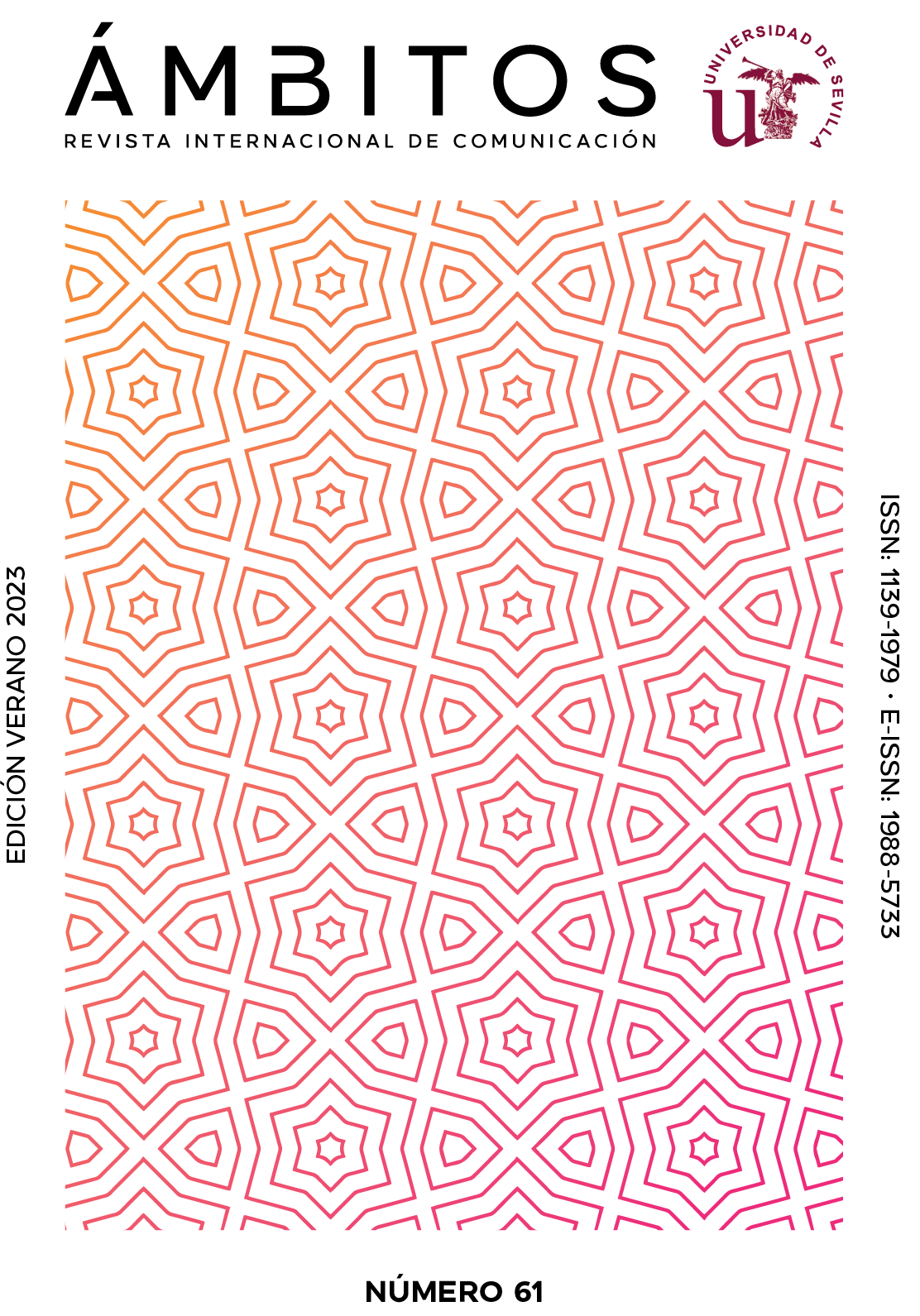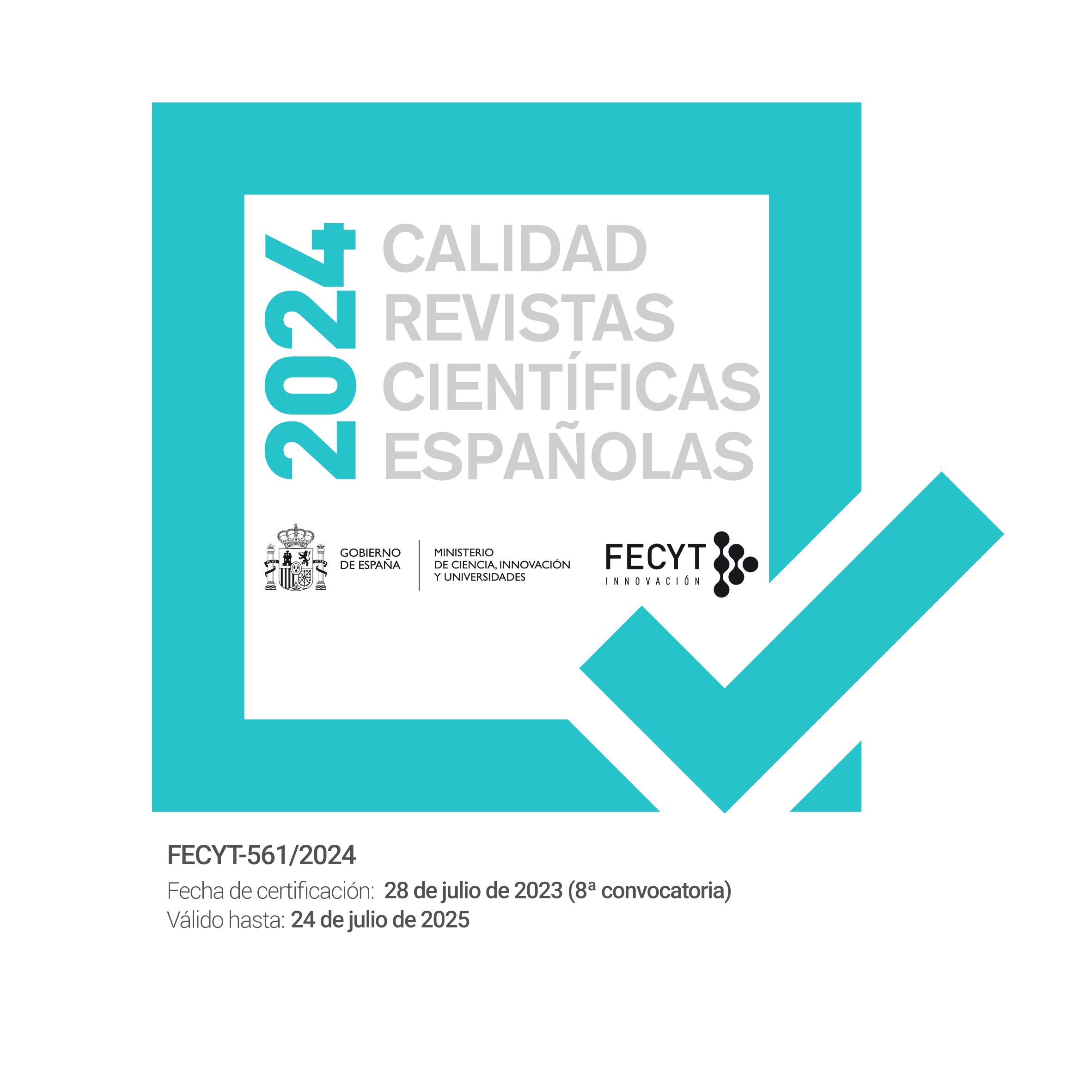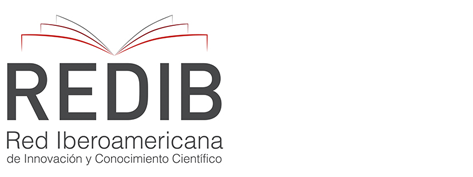Vidas al límite (2008‑2012): A platonic review of the literary journalism of Juan José Millás
DOI:
https://doi.org/10.12795/Ambitos.2023.i61.06Keywords:
Identity, Juan José Millás, Plato, Literary journalism, Vidas al límiteAbstract
In the fourth century BC, The Republic, Plato's culminating work, is born. It summarizes the main ideas of this Athenian philosopher, referring to truth, justice, the State or morality. From the explanation of such concepts, one of the most famous allegories in the history of the humanities is created, the allegory of the cave, with which Plato aspired to explain his vision of reality and knowledge. The myth of the cave, far from losing its significance, has transcended time and influenced contemporary authors. This is the case of the Spanish writer Juan José Millás, whose work, both literary and journalistic, can be interpreted in Platonic terms. To verify this, this article explores one of the most unknown areas of Millás's career: his reports. Specifically, it analyses Vidas al límite, a series of reports that the author published in El País Semanal between 2008 and 2012. Through a methodology that combines a qualitative perspective with a quantitative approach, it aspires to achieve three fundamental objectives: to analyse the notion of identity in these publications; examine the similarities that are generated between their reports and Plato's thought to verify a possible influence; and discover the formal features that define these texts to verify if they are related to his philosophy on identity.
Downloads
Metrics
References
Anastasio, P. (2009). Juan José Millás: la realidad y el delirio. En E. Bou & E. Pittarello (Eds.), (En)claves de la transición: una visión de los Novísimos: prosa, poesía, ensayo (pp. 207–222). Iberoamericana Vervuert. https://doi.org/10.31819/9783954870394‑010
Baudrillard, J. (2000). Pantalla total. Anagrama.
Bértolo, C. (1989). Apéndice a Juan José Millás. En J.J. Millás, Papel Mojado (pp. 183‑213). Anaya.
Busquet, J., & Medina, A. (2017). La investigación en comunicación: ¿Qué debemos saber? ¿Qué pasos debemos seguir? Editorial UOC.
Calva, J. J. (2013). El mito de la caverna como acercamiento a las necesidades de conocimiento e información. Investigación Bibliotecológica, 27(60), 7–11. bit.ly/45AS924
Castells, M. (2000). La era de la información. Economía, cultura y sociedad. Alianza.
Chillón, A. (1999). Literatura y periodismo: una tradición de relaciones promiscuas. Universitat Autònoma de Barcelona. Publicacions de la Universitat Jaume I, Universitat de València.
Cruz, J. (2016). Literatura que cuenta. Entrevistas con grandes cronistas de América Latina y España. Adriana Hidalgo Editora.
Gabilondo, A. (2012). Prólogo. En J.J. Millás, Vidas al límite (pp. 7‑20). Alfaguara.
Genette, G. (1993). Ficción y dicción. Lumen.
Gie Koh, S. (2011). El juego de la identidad en la obra narrativa de Juan José Millás [Tesis de doctorado, Universidad Autónoma de Madrid]. Repositorio Institucional de la UAM. bit.ly/3BX03oP
González Arce, T. (2007). La caverna según Millás. La construcción de la realidad en Todo son preguntas, El ojo de la cerradura y Sombras sobre sombras. En P. Cívil & F. Cremoux (Eds.), Actas del XVI Congreso de la Asociación Internacional de Hispanistas. bit.ly/3IJGzYG
Leunda, M. (2020). Juan José Millás: “La normalidad es uno de los grandes inventos de la modernidad”. Yenny‑El Ateneo. bit.ly/3ikWqm6
Luis, I. G. (2021). La realidad como reflejo del misterio: Jean Baudrillard. En R. Conti & M. Martínez Atencio (Eds.), Alcances extraestéticos de la experiencia del arte. Teseopress. bit.ly/45tIwSN
Millás, J. J. (1994). Ella imagina y otras obsesiones de Vicente Holgado. Alfaguara.
Millás, J. J. (2008a, 3 de febrero). El mundo en sus manos. El País Semanal. https://bit.ly/3NEW3Qz
Millás, J. J. (2008b, 3 de agosto). Biografía de una mosca. El País Semanal. https://bit.ly/46g12hC
Millás, J. J. (2008c, 12 de octubre). El infierno según Ingrid. El País Semanal. https://bit.ly/3PDPfEf
Millás, J. J. (2009a, 7 de julio). Pablo Motos, la hormiga obrera. El País Semanal. https://bit.ly/3Xid0TT
Millás, J. J. (2009b, 25 de octubre). Un sueño en la cabeza. El País Semanal. https://bit.ly/3PnnmjA
Millás, J. J. (2010, 27 de junio). Rubalcaba privado. El País Semanal. https://bit.ly/442X7CQ
Millás, J. J. (2012a, 15 de enero). El ciborg del tercer ojo. El País Semanal. https://bit.ly/445IFtZ
Millás, J. J. (2012b, 11 de marzo). Un país del más allá (Japón primera etapa). El País Semanal, 29–42.
Millás, J. J. (2017). Prólogo: El azar y la necesidad. En I. Menéndez (Ed.), Relatos Clínicos (pp. 9–13). Ediciones Siruela.
Prósperi, G. (2011). Escenas de metaficción en Juan José Millás. CELEHIS: Revista del Centro de Letras Hispanoamericanas, 20(22), 175–197. bit.ly/3OQLQRI
Ródenas, D. (2006). La epistemología de la extrañeza en las columnas de Juan José Millás. En A. Grohmann & M. Steenmeijer (Eds.), El columnismo de escritores españoles (1975‑2005) (pp. 59–78). Verbum.
Ródenas, D. (2016, 12 de octubre). Lo cuerdo de la locura. ElPeriódico.com. bit.ly/3MBLDz9
Rodríguez Santamaría, M. M. (2016). El gran reportaje en los suplementos dominicales de los diarios de información general [Tesis de doctorado, Universidad Complutense de Madrid]. Repositorio Institucional de la UCM. bit.ly/3F8XpPc
Smith, C. E. (2012). Like Prisoners in a Cave: A Problematic Search for Identity and Truth in Two Peninsular Novels. Bulletin of Hispanic Studies, 89(6), 615–625. https://doi.org/10.3828/bhs.2012.47
Sobejano, G. (1992). Juan José Millas: fábulas de la extrañeza. En F. Rico (Ed.) Historia y crítica de la literatura española. Volumen IX: Los nuevos nombres: 1975‑1990 (pp. 249–284) Crítica.
Sobejano, G. (2007). Lección de novelas: España, entre 1940 y ayer. Mare Nostrum.
Tanner, C. (2017). La escritura de Juan José Millás: Un doble beneficio para el público lector. Diablotexto Digital, 2, 67–87. https://doi.org/10.7203/diablotexto.2.10137
Veres, L. (2003). Ironía y paradoja en el texto periodístico de opinión: Juan José Millás. En F. L. Goytisolo (Ed.), La ironía en la narrativa hispánica contemporánea: X Simposio Internacional sobre Narrativa Hispánica Contemporánea (pp. 159–167). Fundación Luis Goytisolo.
Downloads
Published
How to Cite
Issue
Section
License
Copyright (c) 2023 Paula Fuentes Hernández

This work is licensed under a Creative Commons Attribution-NonCommercial-ShareAlike 4.0 International License.
Ámbitos. Revista Internacional de Comunicación is an open access journal, which means that all content is freely available at no charge to the user or their institution. Users may read, download, copy, distribute, distribute, print, search or link to the full text of articles, or use them for any other lawful purpose, without seeking prior permission from the publisher or author. This definition of open access is in accordance with the Budapest Open Access Initiative (BOAI).

Unless otherwise noted, all content in the electronic edition is distributed under a "Creative Commons Attribution-NonCommercial-ShareAlike 4.0 International License". You can consult the informative version and legal text of the licence here. This should be expressly stated in this way where necessary.
In case of acceptance of the manuscript, the authors cede the rights of the work for its publication to Ámbitos. Revista Internacional de Comunicación under the Attribution-NonCommercial-ShareAlike 4.0 International license contract (CC BY-NC-SA 4.0). The authors retain copyright and third parties are authorised to copy, distribute and make use of the work, provided they comply with the terms and conditions set out in the licence
- Cite the authorship and the original source of publication (journal, publisher and URL of the work).
- Do not use them for commercial purposes.
- If you remix, transform or create from the material, you must release your contributions under the same license as the original.
More information can be found at https://creativecommons.org/licenses/by-nc-sa/4.0/deed.es
- Abstract 305
- PDF (Español (España)) 72
- XML (Español (España)) 260


















